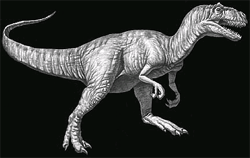The CO<sub>2</sub> factor
 imprints of a bygone era left on rocks indicate that life on Earth was disturbed five times. They also suggest that all was well and then, suddenly, half or more of the species that were around simply vanished. However, after a million years or two, new creatures evolved to fill the gaps left by the old. This mass extinction, according to some, was a result of volcanic activity. Now, a study done by Jennifer McElwain and her colleagues at the University of Sheffield, uk, have added weight to this theory. According to McElwain, the late-Triassic extinction (206 million years ago) was the result of global warming. This warming was so potent that it killed off much of the planet's plants and animals.
imprints of a bygone era left on rocks indicate that life on Earth was disturbed five times. They also suggest that all was well and then, suddenly, half or more of the species that were around simply vanished. However, after a million years or two, new creatures evolved to fill the gaps left by the old. This mass extinction, according to some, was a result of volcanic activity. Now, a study done by Jennifer McElwain and her colleagues at the University of Sheffield, uk, have added weight to this theory. According to McElwain, the late-Triassic extinction (206 million years ago) was the result of global warming. This warming was so potent that it killed off much of the planet's plants and animals.
To prove her point, McElwain counted stomata from 18 different groups of fossil plants that spanned the boundary between the Triassic and the Jurassic periods. They found that the number of stomata decreased progressively and then bounced back shortly afterwards. Comparing the number of stomata on these fossil plants with those found on similar living species, the scientists reckon that the amount of carbon dioxide in the late-Triassic atmosphere quadrupled over the course of a few hundred thousand years.
Such an increase may have raised the global temperature by three or four degrees. Plants, too, provide evidence of this. Photosynthesis stops if a leaf gets too hot. Plants that live in hot climates tend to evolve leaves that are either small or are divided into smaller sub-units so that the air can flow between their parts.
A detailed examination of plants by McElwain, shows that the species which made it from the Triassic to the Jurassic period had small or dissected leaves and so were the new species that appeared in the transition zone.
The scientists concluded that in the late-Triassic period mass extinction was caused by carbon dioxide-induced global warming. Where did the carbon dioxide come from? The scientists concluded that at the beginning of the Triassic period, the world's dry land united in a single continent, known as Pangea. By the end of the period, Pangea was starting to break up. This, was accompanied by massive volcanic activity and in particular by the formation of the so-called Central Atlantic Magmatic Province. A third of a million cubic kilometres of lava, covering seven million square kilometres of the Earth's surface, poured out in a fairly short time period at, or near, the end of the Triassic era. And, when lava pours out of the Earth's interior, so does carbon dioxide.
